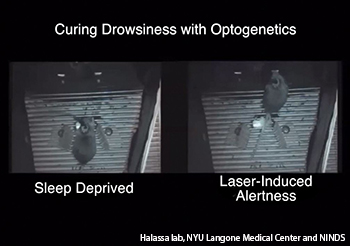
Sleep-deprived mice whose TRN cells had been optogenetically modified were more alert when lasers stimulated wakeful firing patterns (full video).
A group of U.S. researchers has used optogenetics to gain insight on the workings of one of the brain’s internal “switchboards”—a zone that controls the routing of sensory signals from the body to the brain’s higher-order processing centers (Cell, doi:10.1016/j.cell.2014.06.025). Lead author Michael Halassa says that the results could have significant implications for our understanding of brain circuits and, ultimately, the causes of neuropsychiatric disorders.
The research focused on a tiny group of cells in a brain structure called the thalamic reticular nucleus (TRN), which acts as a gatekeeper for signals between the thalamus and the cerebral cortex. Specifically, the team studied a subset of TRN cells that inhibit the transmission of visual information. Multi-electrode studies of mice revealed that these cells fired more frequently while the mice slept, particularly during bursts of brain activity called sleep spindles. The researchers thus hypothesized that these TRN cells are state-dependent, blocking visual information during sleep and allowing the information to pass to the cortex during arousal.
They tested this idea using optogenetics, injecting mice with viruses engineered to deliver the light-sensitive protein channelrhodopsin-2 to the relevant subset of TRN cells. The modification allowed the scientists to turn the inhibitory cells on and off in live mice using laser light (piped in through a fiber-optic link through the mouse’s skull), and thus to test how the state of the cells corresponded with the mice’s ability to concentrate on specific tasks—irrespective of whether the mice themselves were well-rested or sleep-deprived.
The mice had previously been trained to find food through visual cues. Normally, sleep-deprived mice would take longer than others to find the food, as lack of sleep diminishes their ability to concentrate. But when scientists used laser light to prevent the engineered TRN cells from firing inhibitive signals, the mice found the food faster. Conversely, when the team used the lasers to re-create sleep-like patterns in well-rested mice, causing the altered cells to fire more often, those mice took longer and had more difficulty focusing on the task.
Halassa compared the laser to a switch, changing the level of drowsiness in the mice by simulating states of sleep and waking in the TRN cells. Further, this set of cells appears to be only one of numerous sub-networks that make up the TRN. According to researchers, this illustration of the structure of TRN cells is a first step to understanding how this part of the brain influences consciousness.
